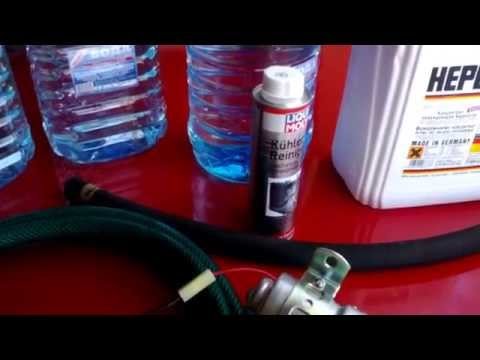
How to flush the engine cooling system
Content
Usually, drivers are given the problem of flushing the internal combustion engine cooling radiator in the summer. It is in the heat that the internal combustion engine overheats most often due to insufficient cooling, due to contamination of the cooling radiator. The structure of the system is such that clogging and insufficient heat dissipation occurs not only due to external factors such as dirt, debris and everything else that the car encounters on our roads, but also due to internal factors - decomposition products of antifreeze, rust, scale inside the system.
In order to flush the internal combustion engine cooling system, several methods can be used. Which one to choose depends on the degree of contamination. The main thing is to avoid banal errors of flushing the system.
Cleaning with distilled water
This method is suitable for new vehicles that do not have obvious visual signs of contamination. For this wash need distilled water, which will eliminate the appearance of scale in the radiator. Obviously, tap water, with a lot of salt and impurities, will not work (remember your kettle after using tap water). Clean water is poured into the radiator and the car starts to idle. After 20 minutes of operation in this mode, the water is drained and new water is poured.
Cleaning with acidified water
Scale may appear in the internal combustion engine cooling system, which over time will simply clog the system and make its performance difficult or even impossible. Normal washing with water here, unfortunately, will not help. For washing, in this case, a special slightly acidic solution is prepared to which vinegar, caustic soda or lactic acid are added.
Flushing with such a solution is similar to flushing with distilled water, with the only difference being that after the car is idling, the fluid is not drained, but left for 2-3 hours in the system. After a maximum of three such procedures, all scale will be removed. Then you need to flush the system once with distilled water, as described above.
When cleaning citric acid you 5 liters of water will need 100-120 g., and if you are going to wash vinegar solution, then the proportion must be taken with the calculation for 10 l. water 500 ml. 9% vinegar.

Flushing the cooling system on Renault

Flushing the cooling system on the Audi 100
Some car owners even use caustic when flushing, but here you need to be very, very careful, because caustic soda can be used only for flushing copper radiators! A solution for such washing is prepared based on 1 liter of distilled water, 50–60 g of soda. Aluminum radiators and cylinder blocks, this also corrodes!
Cleaning with special equipment
Among all the possible options for cleaning the cooling system, there are special liquids on sale. In their composition, they have various chemical solutions that are capable of remove the most serious scale and deposits inside the system. At the same time, the products are gentle on the elements of the car and do not damage them. Such tools can be purchased at car dealerships, and how to use them is indicated on the packages. However, the meaning is the same as with water - the product is poured into the radiator and the car is idling. After rinsing, you need to wash the product with distilled water.
Cleaning the external elements of the radiator
The cooling system requires maintenance not only from the inside, but also from the outside. Dirt, dust, sand, fluff clog between the radiator fins and impair heat exchange with the air. in order to clean the radiator, use a purge or flush with a jet of water.
Be extremely careful with water pressure and physical impact, you can bend the radiator fins, which will also further aggravate the breakdown of the cooling system.